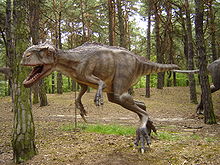Eotyrannus
| Eotyrannus | ||||||||||||
|---|---|---|---|---|---|---|---|---|---|---|---|---|

Partial skeleton of the holotype MIWG 1997.550 |
||||||||||||
| Temporal occurrence | ||||||||||||
| Lower Cretaceous ( Barremium ) | ||||||||||||
| 130.7 to 126.3 million years | ||||||||||||
| Locations | ||||||||||||
|
||||||||||||
| Systematics | ||||||||||||
|
||||||||||||
| Scientific name | ||||||||||||
| Eotyrannus | ||||||||||||
| Hutt , Naish , Martill , Barker & Newbery , 2001 | ||||||||||||
| Art | ||||||||||||
|
Eotyrannus is a genus of theropod dinosaur from Lower Cretaceous Europe and an early ancestor of Tyrannosaurus rex . This genus is assigned to the tyrannosauroids , a related group within the Coelurosauria . The only species and type species , Eotyrannus lengi , is known from a 40 percent preserved skeleton found in southern England ( Isle of Wight ) and probably from the Lower Cretaceous ( Barremium ).
Eotyrannus was four to five meters long and, like most theropods, was a two-legged carnivore . The generic name Eotyrannus means something like "early tyrant" or "tyrant of the dawn", while the epithet lengi honors the fossil collector Gavin Leng, who discovered the skeleton in 1996. In 2001, Hutt, Naish, Martill, Barker, and Newbery published the first scientific description of this animal.
Find
The only skeleton (catalog number MIWG1997.550) comes from the southwest coast of the Isle of Wight and belongs stratigraphically to the Wessex Formation , a rock layer within the Wealden Group. It consists of a partial skull (including the intermaxillary bone, a partial upper jaw (maxillary), the nasal bone , the quadratum , the dental, the lacrimal bone and teeth), elements of the body axis (including the cervical, back and possibly caudal vertebrae ), Shoulder blade , raven bone , some arm bones (including humerus , possibly ulna , radius and hand bones) and some leg bones (including shin , fibula and foot bones).
features
Eotyrannus has a number of features that have also been demonstrated in other tyrannosauroids such as Tyrannosaurus ( synapomorphies ). For example, the teeth of the intermaxillary bone on the front part of the upper jaw were smaller and shaped differently (the cross-section was “D” or “U” -shaped) than the remaining teeth (heterodontics). In addition, the pair of nasal bones was fused and had a rough surface.
The arms, and especially the hands, were exceptionally long in Eotyrannus when compared to other theropods, similar to that of other early tyrannosauroids such as Guanlong . The second finger reached 95 percent of the length of the humerus. In contrast, later tyrannosaurids such as Tyrannosaurus had extremely receding arms and hands. In contrast to the later tyrannosaurids, the third finger of Eotyrannus had not yet receded. Since the skeleton found was only slightly ossified, it is assumed that it was a juvenile specimen.
swell
literature
- Stephen Hutt, Darren Naish, David M. Martill, Michael J. Barker, Penny Newberry: A preliminary account of a new tyrannosauroid theropod from the Wessex Formation (Cretaceous) of southern England . In: Cretaceous Research. Vol. 22, No. 2, 2001, ISSN 0195-6671 , pp. 227-242, doi : 10.1006 / cres.2001.0252
Web links
- Eotyrannus on DinoWight (English)
Individual evidence
- ^ Gregory S. Paul : The Princeton Field Guide To Dinosaurs. Princeton University Press, Princeton NJ 2010, ISBN 978-0-691-13720-9 , p. 100, online .
- ↑ Thomas R. Holtz Jr .: Tyrannosauroidea. In: David B. Weishampel , Peter Dodson , Halszka Osmólska (eds.): The Dinosauria . 2nd Edition. University of California Press, Berkeley CA et al. 2004, ISBN 0-520-24209-2 , p. 129.
